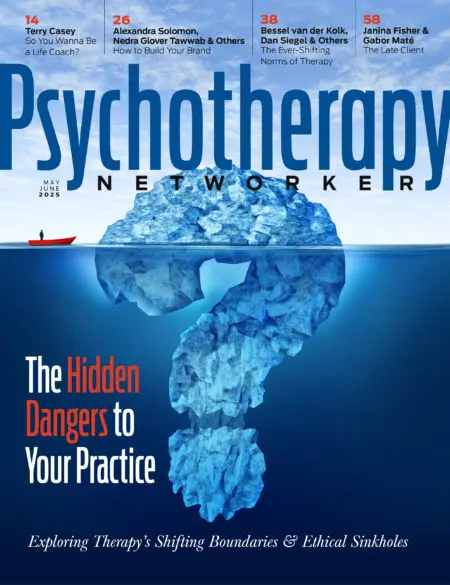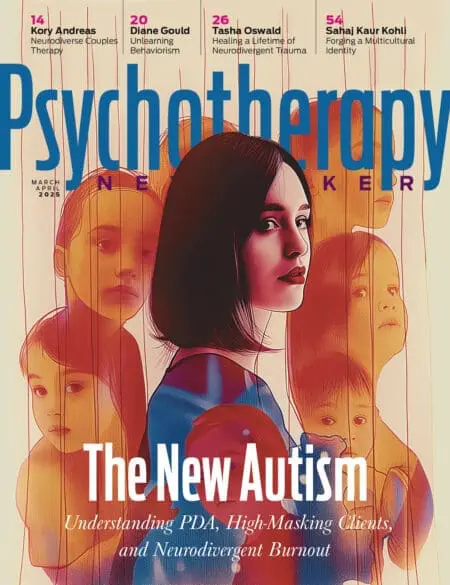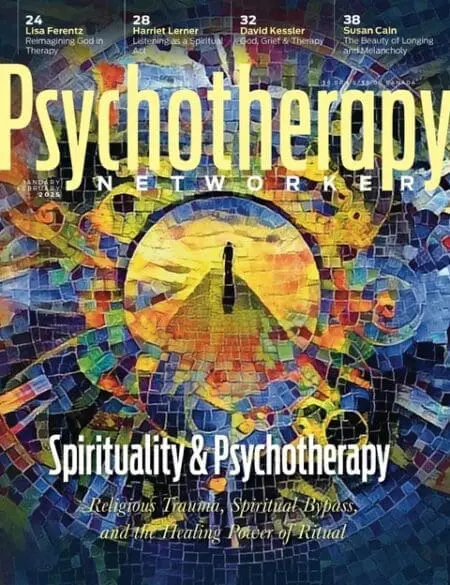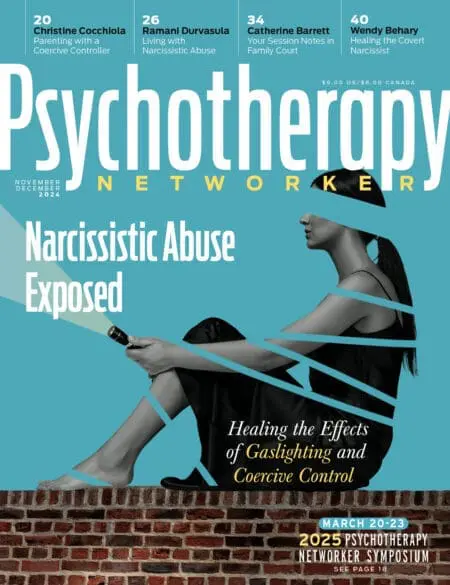Couples therapy is complex. With two people in the room, often at odds with one another, and with relational dynamics playing out quickly in real time, figuring out where to intervene can feel like a high-wire circus act. But having spent over 30 years as a couples therapist, I’ve learned that one of the most valuable tools we can bring to couples work is flexibility. When our efforts eventually stall—and in couples therapy, they often do—we need to be open to trying something different, even unconventional.
For years, I’ve used emotionally focused couples therapy (EFCT) with my clients. It’s an attachment-based roadmap that’s considered one of the most well-researched and effective approaches out there. But EFCT, like any approach, isn’t perfect. Research shows that about 70 percent of couples experience significant healing from relationship distress after EFCT; that leaves 30 percent who continue to feel stuck. With those clients, I sometimes add EMDR to our therapy, which helps many of them make the internal shifts necessary for change. But even still, some couples remain stuck in maladaptive behavioral patterns.
In 2021, I decided to try something unusual: I sought training in psychedelic somatic interactional psychotherapy (PSIP). A colleague had shared that PSIP could help clients go even deeper than EMDR to move them through particularly tough attachment trauma blocks. The training consisted of five days of experiential workshops and classroom learning, including observation, debriefs, and integration work with fellow students who, under supervision, had taken legally prescribed ketamine and cannabis. Afterwards, I completed a four-month online supervision series with the same team. I immediately loved how the approach privileged the therapist-client relationship, while also allowing a gentle exploration of wounded and well-defended places.
As I got more comfortable with the PSIP model, I wondered whether I could blend it with EFCT. Fittingly, by the time I was completing my training, a couple with whom I’d been using EFCT for more than a year presented me with an excellent opportunity to see how psychedelic-assisted therapy might complement EFCT.
Stuck, and Stuck Again
Sarah and Cole, both in their 50s, had been married for 32 years when they came to me for couples therapy. The last of their four daughters had graduated from college, and the time felt right, they told me, to address some issues that had been eroding their connection.
Cole and Sarah had different theories about how this erosion had happened: Sarah believed Cole’s failure to support her during significant moments in her life, like when her mother died from cancer, had contributed to it. As a result, Sarah said she didn’t trust Cole to show up for her. Cole, meanwhile, thought Sarah needed to be less critical and more accepting. He’d grown tired of feeling like he would never be forgiven for past mistakes. They’d also stopped having sex, which bothered both of them, but especially Cole. Despite these problems, it was clear that they loved each other and wanted to make their marriage work.
There are two stages in EFCT. In the first, the therapist helps partners learn to see their negative cycle, not the other person, as the problem. This helps each partner build a tolerance for emotion (both theirs and their partner’s) and become more aware of how once-adaptive childhood responses have become maladaptive. As couples recognize the negative cycle and begin to interrupt it, they can identify and focus on their own attachment needs and regulate their emotions more easily. With practice, they feel increasingly safe taking emotional risks with each other. Afterwards, they’re ready to move to stage two of EFCT, where they can have deep, vulnerable conversations, and uncover new parts of themselves.
Cole and Sarah were able to make significant inroads in stage one. Sarah explored how being raised by an emotionally absent, shaming father had impacted her sensitivity to Cole. In Cole’s case, he began to recognize that shutting down to Sarah came naturally. He’d long absorbed messages about the “pointlessness” of negative emotions in his family of demanding intellectuals, who believed that any talk about distressing feelings constituted “wallowing.”
In EFCT lexicon, Sarah was a pursuer, who preferred to address relationship issues head-on and resolve them quickly, and Cole was a withdrawer, which meant he needed more time to process emotions. As a withdrawer, Cole would frequently pull away from Sarah during difficult discussions, and as a pursuer, Sarah found it difficult to table conversations when they got too heated for Cole. When a couple is made up of a pursuer and a withdrawer, they can negatively influence one another: the more the pursuer pursues, the more the withdrawer withdraws, and vice versa.
Although they certainly experienced moments of improved communication and were learning more about their negative cycle and maladaptive practices, eight months into treatment, they remained stuck in stage one. Even when Sarah was trying to express vulnerability, her tone inevitably became sharp. She bristled easily. Too often, Cole responded cooly and transactionally to her pleas for closeness or consideration. To make further progress, I knew they’d have to push through a lifetime of learned defensiveness and get in touch with something deeper: the core struggle of their unmet attachment needs.
The Experiment
A possible foothold emerged when Sarah told me that at a friend’s recommendation, she’d talked with someone who had a medical background and was trained as a psychedelic journey guide. The friend and her partner had done a couples MDMA journey with this guide and felt profoundly changed by it. Sarah was excited by the prospect and had already talked at length with her about how their safety would be prioritized if she and Cole did it, too. Although MDMA isn’t legal, they knew of practitioners guiding journeys all over the country.
Since I’d recently wrapped up my own training in psychedelic-assisted therapy, I knew that in a safe and supported space with a knowledgeable and well-trained guide, psychedelics might help Cole have a lived experience of the absence of performance anxiety so that he could fully show up for Sarah. And I hoped that for Sarah, they’d lower the protective barrier that had been keeping her so vigilant and made her appear controlling, enough to allow her softness and longing to come through. Although I remained neutral about their choice, I let both Cole and Sarah know I was here to help them explore their goals and misgivings about a journey, and to do the integration work afterwards.
To prepare for their experience, we reviewed what they’d learned so far from EFCT about their triggers, negative cycle, and the importance of resourcing themselves through bonding moments like the ones they’d had in our sessions. After several consultations with the guide, they made the decision to start with individual ketamine sessions and then jointly take MDMA a couple months later. Cole worried that his defenses were so entrenched that psychedelics wouldn’t affect him, but said he was willing to give them a try. Sarah was openly excited. Her hope was that it would make it easier for them to talk about things like money and sex without their usual defensiveness.
In our last session before the weekend when their journey was scheduled, they told me they felt ready. I replied that I looked forward to our next session, the following week.
A Breakthrough
When we met for our next session, Cole and Sarah greeted me and sat down next to each other, as they always did. But when they spoke to each other, I noticed that something subtle had shifted. They appeared to be more at ease in their bodies, and there were little gestures that were new—or perhaps they were simply more frequent. They leaned toward each other, held each other’s gaze, and smiled more. When they shared, I could sense that much of their defensiveness had melted. Sarah’s tone had lost its sharp, instructive quality, and Cole’s responses were noticeably warmer.
Their psychedelic journey had been positive overall, they told me. Cole had felt his inhibitions dissolve, and had found that he was able to show up more authentically with Sarah, asking for what he needed both emotionally and physically. Sarah, in turn, said she’d felt seen and appreciated by Cole, adding that she could now feel the sense of safety with him that she’d been yearning for, which allowed her to fully express her love for him.
When Cole went back to work on Monday after the journey, he told me, he’d been surprised at just how calm he felt, even during a stressful work presentation. “For the first time in years,” he said, “I experienced a profound sense of tranquility when people were expecting me to do something.”
Together, Sarah and Cole identified practical ways they might sustain insights from their journey through daily practices like prioritizing time together and addressing moments of hurt. They began nipping conflicts in the bud and tabling contentious discussions until our sessions.
Their readiness for stage two crystallized in a following session when Cole said, “Something’s been bothering me, and I’m afraid to bring it up, but I’m going to anyway.” Sarah sat up in her chair and nodded.
“Last week, when your family visited, I took care of everything so you could enjoy time with them. I picked everyone up from the airport, cooked, and participated in activities I don’t particularly enjoy. But after they left, all you did was talk about being tired. That hurt. It felt like what I’d done hadn’t mattered.”
“You’re right,” Sarah replied. “It didn’t even occur to me to acknowledge how much you’d done to make the visit work.”
“I’m wondering how it landed when you were working so hard to get it right and Sarah didn’t seem to notice,” I asked.
“Like a rejection,” Cole replied. “Only this time, instead of shutting down, I reminded myself that this was the pattern we’ve been talking about. And that Sarah still loved me.”
In another session, Sarah talked about her maladaptive strategies, without any intervention from me. “I never realized it before,” she said, turning to Cole, “but I can see now that there were many times when I hurt you when I felt hurt instead of telling you how I felt. I couldn’t see how I was just pushing you further away.” Instead of buying into her familiar judgements of Cole, Sarah was developing a better understanding of her own maladaptive patterns.
Before their psychedelic journey, both of them had understood their negative cycle cognitively. Now, they felt the negative cycle, understood their roles in creating it, and could see the impact it had on their relationship.
“For the first time in a long time, I’m feeling seen, heard, and understood,” Sarah said in one of our last sessions. “And I see how Cole’s nervous system works, why he used to freeze up or lean away when I’d push him to share more and be more vulnerable. I was basically saying, ‘You’re failing.’”
“I feel connected to Sarah in a way I’m not sure I’ve ever felt,” Cole said. “I think it’s because I have more compassion for myself.”
I’ve long known it’s important to be nimble in therapy—to move between approaches based on what’s unfolding in front of us—but I’d never thought seriously about integrating two approaches that look so different. I’m glad I did, and was able to support Cole and Sarah’s choice to step out of their comfort zone and try something that to them, and to many therapists, still feels radical and new.
Psychedelics were the tipping point that helped Sarah and Cole lower their defenses and be truly vulnerable and empathetic. At the same time, they weren’t the sole reason for their breakthrough. The EFCT work we’d done, and continued to do afterward, helped them grow more aware of maladaptive patterns, improve their ability to regulate their emotions, identify and interrupt their pursue-withdraw cycle, have more connected conversations, and identify and communicate attachment longings.
I’ve continued to support clients who opt for psychedelic-assisted therapy because they’ve felt stuck after years of using more conventional therapy methods and treatments. There are many pathways to healing, including ones that might seem a little unusual. When we’re open-minded and follow our clients’ lead, the results are often beautiful.
Case Commentary
Naomi Rather’s case study is a testimony to the importance of keeping an open mind and being flexible as therapists, as it seems that integrating psychedelics helped Sarah and Cole achieve what can be an elusive but crucial goal for couples in the first stage of EFCT: moving beyond a cognitive understanding of their interaction cycle and actually feeling how their own fears and longings manifest in the relationship and the impact they have on everything.
Therapists who practice EFCT often hear their clients say things like, “Yes, I know it’s about the cycle, but what are we supposed to do about it? My partner keeps behaving this way!” As long as couples’ handle on their cycle remains cognitive, de-escalation is extremely difficult. I share Rather’s view that experiencing the cycle as the problem means confronting unmet attachment needs and the feelings that accompany them, which also entails, as Rather so elegantly says, “pushing through a lifetime of learned defensiveness.”
Like Rather, I often focus on guiding clients through blocks to de-escalation. When they have difficulty feeling their cycle, I will use a great deal of repetition, reflecting that the regular conflicts they experience are responses to unmet attachment needs, and that they are only revealing a fraction of what is happening inside them. I find that constant reframes of the cycle as the problem can help them gain new perspectives of their partner, and jump-start vulnerable discussions about their role in the cycle. From this new place, a partner might say something like, “I pull away from you because I’m hurt and afraid” or “I pound on the door because I don’t know any other way to reach you, and I’m so lonely.”
I tend to favor these types of interventions over psychedelics since drugs like MDMA aren’t legally available in the U.S., and in Canada practitioners must apply for special permission to prescribe them. Last August, the FDA declined to approve MDMA-assisted psychotherapy as a treatment for PTSD, citing the need for more evidence of its safety and effectiveness. And although there is some anecdotal evidence for the successful integration of psychedelics into EFCT, there has not yet been any empirical research into its effectiveness or safety.
I’m hopeful that with more definitive research results, it will eventually become commonplace for therapists, including couples therapists, to collaborate with medical practitioners who administer and monitor psychedelics within the context of psychotherapy. After all, when Sarah and Cole took it upon themselves to experience a psychedelic journey with a trained guide, they became more accessible and responsive to each other. They felt their way through their cycle to a more meaningful emotional connection. The combination of EFCT and psychedelics might have helped them overcome the blocks to de-escalation and to proceed to stage two.
Naomi Rather
Naomi Rather, PhD, is a therapist in private practice in Newington, New Hampshire, where she specializes in grief, couples work, and trauma. She’s the co-founder of Seacoast EFT, which provides training, peer supervision, and collaborative opportunities to therapists trained in EFCT. She’s the co-host of the podcast That Relationship Show, as well as a former adjunct faculty member in the MSW program at The University of New Hampshire in Durham.












